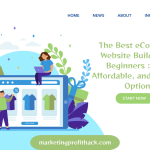Welcome to my article “Top 10 Skills Every Successful Freelance Digital Marketer Should Master”. So, you’ve decided to dive into the wild and wonderful world of freelance digital marketing. Maybe you’re ready to swap your 9-to-5 grind for a laptop lifestyle (cue the beach photos and coffee shop vibes), or perhaps you just realized your boss was never going to appreciate your deep knowledge of SEO and Google Ads. Either way, you’re in for a fun ride!
But here’s the catch: digital marketing is a vast field. If you want to stand out from the crowd (and not get lost in the endless sea of “I’ve got 10 years of experience” freelancers), there are key skills you need to master. Sure, you can technically Google your way through everything, but let’s face it — nothing beats having a well-rounded toolkit of expertise under your belt.
Whether you’re crafting killer email campaigns, optimizing websites, or managing social media accounts that make brands look like they’re on fire (in a good way), mastering the right skills is essential. In this article, we’re breaking down the top 10 skills that can turn a newbie freelancer into a rockstar digital marketer. Don’t worry — we’ll keep it light, fun, and actionable, so you can hit the ground running and not get stuck on the digital equivalent of a traffic jam. Ready? Let’s dive in!
Proven Formula for $50-$100 Daily Income with 0 COST – Watch This FREE Video >>

Mastering freelance digital marketing isn’t about picking one skill and winging it — it’s about building a powerhouse combo. It starts with Search Engine Optimization (SEO), the bedrock that makes sure your content doesn’t just sit in the abyss of page 87 on Google. Then there’s Content Marketing & Copywriting, because even the best ideas need words that actually sell. Social Media Marketing is next — where memes meet strategy. Don’t forget Data Analytics & Reporting — because numbers tell better stories than you think. Paid Advertising (PPC) helps you throw money at results (the smart way), while Email Marketing keeps your brand in inboxes and hearts. Conversion Rate Optimization (CRO) fine-tunes your campaigns for max results. Marketing Automation saves you from living inside your inbox, and Client Management & Communication Skills make sure you stay professional even when a client sends you “urgent edits” at midnight. Finally, Time Management & Organization ensures you survive it all — preferably with coffee still in hand. 🚀
Search Engine Optimization (SEO): The Bedrock of Digital Success
Let’s face it — in the vast sea of digital content, if you’re not showing up in search results, it’s like you’re speaking to an empty room. That’s where SEO comes in — the magic ingredient that boosts your visibility and helps you get found by the right audience at the right time. If you’re a freelance digital marketer (or aspiring to be one), mastering SEO is non-negotiable. Think of it as your ticket to the big league of digital marketing, where traffic, leads, and clients flow freely.
What is SEO and Why Does It Matter?
At its core, SEO is the art and science of making your website, blog post, or product page more visible to search engines like Google, Bing, and Yahoo. Search engines use complex algorithms to determine which pages rank higher for certain keywords. The better your content aligns with what people are searching for, the more likely it is to appear at the top of search results.
Why does this matter? Because people are searching for solutions to their problems every single day. Whether it’s how to fix their car, where to find the best yoga classes, or looking for expert freelance marketers (like you!) — SEO is the bridge that connects your content to these potential clients. Without it, your beautifully crafted blog post or killer landing page might as well be invisible.
Core Aspects of SEO Every Marketer Should Master
Now that we’ve established that SEO is crucial, let’s break down the essential components you’ll need to master as a freelance digital marketer:
- On-Page SEO: This is where you make sure your content is optimized for both search engines and human readers. This includes using the right keywords in your title, headers, and throughout your copy. You also want to make sure that your meta descriptions are compelling and your images have alt text that’s optimized for search engines. It’s all about making it easy for Google to understand what your page is about — and even easier for humans to enjoy reading.
- Off-Page SEO: Backlinks are the golden ticket here. When other authoritative websites link to your content, it signals to search engines that your content is trustworthy and valuable. But don’t rush into getting backlinks from any random site — quality is always better than quantity. Building meaningful relationships and guest posting on reputable blogs can get you those high-quality backlinks.
- Technical SEO: Sounds fancy, but in simple terms, it’s making sure that search engines can crawl, index, and understand your website. Think page speed, mobile responsiveness, and an easy-to-navigate site structure. For freelance marketers, this means you need to have a basic understanding of how to optimize website performance. For instance, if your website takes forever to load, users won’t stick around — and neither will search engines!
- Local SEO: If you’re targeting clients in specific geographic areas (hello, local businesses!), then you can’t ignore local SEO. This means optimizing your website for location-based keywords and getting listed in local directories like Google My Business. You want to show up when someone nearby searches for services you offer.
Why SEO Is the Freelance Marketer’s Best Friend
So, what’s in it for you as a freelancer? Well, once you understand SEO, you’ll be able to generate organic traffic — which is essentially free traffic. It’s like investing your time and effort in building a strong foundation that pays off in the long run. The more skilled you get at SEO, the easier it becomes to drive potential clients to your website without having to rely on paid ads or begging for referrals.
Moreover, SEO allows you to build long-term, sustainable growth for both yourself and your clients. Unlike paid ads, which stop working the minute you stop paying, SEO’s effects compound over time. When you rank high on search engines, it brings in a steady flow of traffic and potential clients without the constant hustle.
SEO Tools to Help You Along the Way
Of course, doing SEO manually can be a bit overwhelming, but fortunately, there are tons of tools to make it easier. Here are a few to keep in your digital marketing toolkit:
- Google Analytics: To track website performance, visitor behavior, and conversions.
- Google Search Console: A must-have for monitoring your website’s health and understanding how search engines see your site.
- SEMrush/Ahrefs/Moz: These are your go-to tools for keyword research, backlink analysis, and competitor research.
- Yoast SEO (for WordPress users): This plugin will guide you through optimizing your content, from keyword usage to readability.
Pro Tip: SEO is a marathon, not a sprint. It takes time to see significant results, but once you start getting that sweet organic traffic, you’ll wonder why you didn’t dive into SEO sooner. Keep experimenting, stay up to date with Google’s ever-evolving algorithm, and never underestimate the power of consistency.
Content Marketing & Copywriting: Crafting Content That Converts
Let’s be real: content is king. But not just any content. We’re talking about content that captivates, engages, and, most importantly, converts. If you’re a freelance digital marketer, mastering the art of content marketing and copywriting is like unlocking a superpower. Think about it — no matter what service you’re offering, whether it’s social media marketing, SEO, or email campaigns, the words you write are your ultimate tool for persuasion. The right content can transform browsers into buyers, and followers into loyal customers. But how do you craft content that actually converts? Let’s dive into the dynamic duo of content marketing and copywriting.
Content Marketing: The Big Picture
Content marketing is the strategy behind the content you create. It’s all about delivering valuable, relevant, and consistent content to your audience with the goal of driving profitable customer action. It’s not just about writing blog posts and sharing memes on social media (though those are part of it). Successful content marketing is a holistic approach that includes understanding your audience, providing solutions to their problems, and establishing your authority in the industry.
The key to content marketing is knowing your audience inside and out. What are their pain points? What do they care about? What are they searching for? Once you answer these questions, you can create content that resonates with them. Whether you’re writing a blog post, producing a podcast, or creating videos, each piece of content should be designed to build trust, nurture relationships, and guide your audience down the sales funnel.
Copywriting: Turning Words into Money
Now, let’s talk copywriting. While content marketing focuses on the broader picture, copywriting is the fine art of crafting words that drive action — you know, the stuff that gets people to click “buy now,” sign up for a newsletter, or fill out that contact form. Great copy isn’t about being flashy; it’s about being clear, persuasive, and aligning your message with your audience’s needs.
Proven Formula for $50-$100 Daily Income with 0 COST – Watch This FREE Video >>
As a freelancer, you’ll need to understand the psychology of persuasive writing. It’s all about creating an emotional connection, showing the value of what you’re offering, and making it crystal clear why your audience should care. Whether it’s an email campaign, a landing page, or a sales page, effective copy is like a well-crafted sales pitch that keeps your audience hooked from the first sentence to the last.
Key Elements of Content Marketing That Converts
- Know Your Audience Like You Know Your Best Friend: As we mentioned, the first step to crafting content that converts is understanding your audience. Dive into their needs, wants, and pain points. The better you understand them, the more effective your content will be. Personas, surveys, and social media monitoring can give you a clear picture of who you’re writing for.
- Provide Solutions to Their Problems: If your content isn’t solving a problem, it’s not going to convert. Whether you’re creating a blog post, an email, or a social media post, make sure it answers a question or solves an issue your audience is facing. Educational content, how-tos, and case studies work wonders in this department.
- Create Compelling Calls to Action (CTAs): Let’s talk about the most important part of any copy: the call to action. After all, what’s the point of all this great content if you’re not telling your readers what to do next? Whether it’s asking them to download a guide, book a consultation, or subscribe to your newsletter, a strong CTA drives your audience to take the next step.
- Craft Engaging Headlines and Hooks: Your headline is the first thing people see, and if it doesn’t grab their attention, they’ll keep scrolling. Spend time crafting headlines that spark curiosity or promise a benefit. The same goes for the opening lines of your content — you need to hook your reader in right away.
- Tell Stories: People remember stories. They connect with them. So, don’t be afraid to use storytelling in your content. Whether you’re sharing a client success story, your personal journey, or a case study, weaving narratives into your content makes it relatable and engaging.
- Be Authentic and Human: No one likes a robotic sales pitch. Keep your tone conversational, human, and approachable. Whether you’re writing a blog post or crafting a social media update, let your personality shine through. Authenticity is what builds trust, and trust leads to conversions.
The Synergy Between Content Marketing & Copywriting
While content marketing and copywriting might seem like two separate things, they work best when combined. Content marketing gives your audience valuable information and helps them get to know, like, and trust you. Copywriting, on the other hand, drives your audience to take specific actions that lead to conversions. When you marry the two, you’ve got a powerful recipe for success.
For example, let’s say you’re writing a blog post (content marketing) about how to increase website traffic. The content educates the reader, but at the end, you include a persuasive call to action (copywriting) encouraging them to sign up for your SEO services. That’s content marketing and copywriting working hand-in-hand.
Tools to Boost Your Content Marketing & Copywriting Game
There are a few tools out there that can help you craft content that really packs a punch:
- Google Analytics: This tool helps you understand what content is resonating with your audience and how they’re engaging with it.
- BuzzSumo: Great for researching trending topics and understanding what type of content is performing well.
- Grammarly: A must-have for any copywriter. It ensures that your content is error-free and grammatically correct.
- CoSchedule Headline Analyzer: A tool that helps you craft click-worthy headlines by scoring them based on their effectiveness.
Pro Tip: Don’t forget about SEO when creating content. The best-written content in the world won’t do you much good if no one can find it. Optimize your content with the right keywords, internal links, and meta descriptions to ensure that it gets the visibility it deserves.
Social Media Marketing: Mastering the Platforms Your Clients Love
Let’s be honest — if you’re not on social media these days, do you even exist? It’s where the magic happens. Whether you’re posting memes, sharing business insights, or launching your next viral campaign, social media is where it all goes down. As a freelance digital marketer, mastering social media marketing isn’t just a nice-to-have skill — it’s a must. It’s how you engage with your audience, build brand loyalty, and, let’s not forget, convert followers into paying customers. So, let’s talk about how to master the platforms your clients love and become the social media marketing wizard you were destined to be.
Understanding the Social Media Landscape
With so many platforms out there, it can feel like trying to pick the right shoes for a night out — do you go with the bold statement heels (TikTok) or the classic sneakers (Facebook)? It’s important to understand the unique characteristics of each platform and how they align with your client’s business goals. Not every platform is right for every business. Some might be great for visual-heavy brands (hello, Instagram!), while others are more suited for thought leadership and professional connections (looking at you, LinkedIn). Knowing which platform to focus on can save you time, energy, and potentially, your client’s marketing budget.
But before you dive into creating content, take a step back. Understand your client’s audience. What are they interested in? Which platform are they most active on? Are they checking out new products on Instagram? Or are they reading insightful business tips on LinkedIn? When you understand where your target audience hangs out, you can focus your efforts on the platforms that matter the most.
Platform Breakdown: Which Social Media Channels Matter Most?
Facebook: The All-Purpose Powerhouse
Ah, Facebook — the OG of social media platforms. With over 2.8 billion monthly active users, Facebook remains one of the most versatile platforms for businesses. Whether you’re targeting Gen Z or baby boomers, Facebook has something for everyone. As a freelancer, you can create ad campaigns, manage Facebook groups, run polls, and optimize your client’s page to reach the right audience. Plus, its advanced targeting capabilities for paid ads are like a marketer’s dream come true.
But don’t just take your clients’ budget and boost posts willy-nilly. Focus on creating content that invites engagement, whether it’s through eye-catching visuals, shareable articles, or live streams. Facebook is where you nurture relationships and build community — not just push for sales.
Instagram: The Visual Playground
If your client’s brand is anything visual — fashion, food, fitness, or even tech gadgets — Instagram is a must. With over 1 billion active monthly users and a highly engaged audience, this platform is perfect for showcasing your client’s products or services in a visually compelling way. Whether it’s through Stories, IGTV, Reels, or traditional posts, Instagram’s emphasis on stunning visuals, short-form content, and influencer marketing makes it ideal for boosting brand awareness.
But remember, Instagram isn’t just about pretty pictures. It’s about storytelling. Use captions, hashtags, and features like polls or quizzes to engage with followers and keep the conversation flowing. Don’t forget to keep an eye on Instagram’s constantly changing algorithm and experiment with new features to stay relevant.
Twitter: The Newsfeed of the Internet
If your client is looking to build real-time engagement, Twitter is where the action happens. With its fast-paced, news-driven environment, Twitter allows for quick interactions and up-to-the-minute updates. Hashtags are the bread and butter of Twitter, so be sure to research the latest trending topics and create content that fits in with the ongoing conversation.
For businesses that rely on being in the know — tech startups, media outlets, or even local businesses announcing sales — Twitter is perfect. It’s also a great platform for building brand personality. Whether your client wants to engage in witty banter or participate in thought-provoking discussions, Twitter is the place for your voice to be heard loud and clear.
LinkedIn: The Professional Networking Hub
When it comes to B2B marketing, LinkedIn is the platform you don’t want to ignore. It’s all about professional networking, establishing thought leadership, and showcasing industry expertise. Whether your client is looking to generate leads, build connections, or position themselves as an authority in their field, LinkedIn is essential. It’s not just about posting updates — it’s about sharing valuable insights, engaging in meaningful conversations, and being seen as an expert in your client’s industry.
For freelance digital marketers, LinkedIn is also a powerful networking tool. Build your profile, connect with industry peers, and share case studies or success stories to showcase your work.
TikTok: The New Kid on the Block with Major Potential
Let’s face it, TikTok has taken the world by storm. With its addictive short-form videos, it’s the perfect platform for creative brands and marketers who want to go viral. Brands that can create funny, relatable, or eye-catching content stand a good chance of connecting with millions of users — especially if they tap into trending challenges or use popular sounds.
While TikTok might not be right for every business, its explosive growth and highly engaged audience make it an exciting platform to explore, especially for younger, trend-conscious demographics. As a freelancer, you’ll need to get creative here, thinking outside the box to come up with fresh, fun content that resonates with your client’s target audience.
Mastering Social Media Strategy: The Key to Success
Once you’ve chosen the right platform (or platforms), it’s time to develop a social media strategy that aligns with your client’s goals. Start by defining clear objectives — is the goal to build brand awareness? Drive traffic to the website? Increase engagement? Once you know the “why,” you can craft a content plan that achieves those goals.
A good strategy also means consistency. From post frequency to content style, staying consistent in messaging and posting helps to build trust and recognition with your audience. Use a social media calendar to stay organized and ensure your content is planned ahead of time.
Social Media Tools Every Freelance Digital Marketer Should Know
There are plenty of tools to help streamline social media marketing and ensure you’re staying on top of trends and analytics:
- Hootsuite/Buffer: For scheduling posts and managing multiple social media accounts in one place.
- Canva: A user-friendly design tool for creating eye-catching graphics for your posts and ads.
- Sprout Social: A social media management platform that helps with engagement, scheduling, and analytics.
- Google Analytics: To track the traffic driven to your website from social media channels and measure ROI.
Pro Tip: Don’t be afraid to experiment. Social media is ever-evolving, and the platforms you’re marketing on today might look totally different tomorrow. Stay up-to-date with trends, adapt to new tools and features, and above all, always be ready to evolve your strategy to meet the changing needs of your clients.
Data Analytics & Reporting: Turning Numbers into Strategy
Let’s face it: If you’re not tracking your digital marketing efforts, are you even really marketing? Data analytics and reporting are the unsung heroes of digital marketing. They take your hard work — those beautiful social media posts, that SEO-optimized blog, the perfectly crafted email campaign — and turn them into something even better: strategy. Without data, you’re just guessing. With it, you’re making informed decisions that can seriously boost your ROI and help you refine your marketing tactics. So, let’s dive into why mastering data analytics and reporting is non-negotiable for any freelance digital marketer looking to level up.
The Power of Data: Why It’s More Than Just Numbers
At first glance, data can seem like a confusing mess of numbers, charts, and percentages. But once you know how to interpret it, data is your secret weapon. Imagine running a marketing campaign without any idea of how it’s performing — sounds like a nightmare, right? That’s where analytics comes in. It helps you understand what’s working and what’s not, giving you valuable insights into customer behavior, engagement rates, conversion paths, and more.
Proven Formula for $50-$100 Daily Income with 0 COST – Watch This FREE Video >>
Think of data as the ultimate cheat sheet for your digital marketing strategies. It tells you who’s visiting your website, where they’re coming from, how long they stay, and whether they’re actually buying your product or just window shopping. By analyzing this data, you can tweak your tactics in real-time, making sure your campaigns are as effective as possible.
But here’s the kicker: it’s not just about collecting data. It’s about using it to create smarter, more efficient strategies that push your client’s business forward. After all, what’s the point of having all that data if you don’t know what to do with it?
What Data Should You Be Tracking?
To really turn numbers into strategy, you need to know which metrics to pay attention to. Here’s a breakdown of the most important ones for freelance digital marketers:
- Website Traffic: You’ve got a beautiful website, but is anyone visiting it? Google Analytics is your best friend here, showing you where your visitors are coming from (organic search, social media, direct visits, etc.), how long they stay, and which pages are the most popular. This helps you understand what’s driving traffic to your client’s site and what needs improvement.
- Conversion Rate: All that traffic is great, but is it converting into sales, sign-ups, or other desired actions? The conversion rate tells you how well your website (or landing page) is persuading visitors to take action. If your conversion rate is low, it’s time to dig into your funnel and figure out where things are going wrong.
- Bounce Rate: A high bounce rate means people are landing on your site and leaving quickly — not a great sign. This could mean that the page isn’t engaging enough or doesn’t match what the visitor expected. By keeping an eye on your bounce rate, you can make quick adjustments to keep visitors engaged and lower that number.
- Engagement Metrics: Whether you’re posting on social media, sending out emails, or running paid ads, engagement metrics like likes, comments, shares, and click-through rates (CTR) are key indicators of how well your content resonates with your audience. If your engagement rate is low, it might be time to tweak your messaging or try a different content format.
- Customer Acquisition Cost (CAC): How much does it cost to acquire a new customer? By tracking CAC, you can assess whether your marketing efforts are cost-effective. If you’re spending a lot on ads and promotions but your CAC is through the roof, it may be time to rethink your strategy.
- Lifetime Value (LTV): LTV tells you how much revenue a customer is likely to generate over their entire relationship with your brand. The higher the LTV, the more valuable the customer. By analyzing LTV, you can prioritize retaining loyal customers rather than constantly focusing on acquiring new ones.
- Social Media Analytics: Each platform has its own suite of analytics tools (like Facebook Insights, Instagram Analytics, or LinkedIn Analytics) to measure things like follower growth, engagement, and reach. These insights will help you fine-tune your social strategy and create content that’s more likely to hit the mark.
Turning Data into Strategy: How to Make It Work for You
Okay, so now you know what to track. But how do you turn all this data into actionable strategy? It’s all about the story the numbers tell. Once you’ve gathered your data, look for patterns. Are people engaging more with video content than blog posts? Maybe you should focus more on creating video ads or social media posts. Is a certain demographic (say, millennials) engaging more with your client’s ads? Tailor your content to appeal to them specifically.
It’s also about constant optimization. Data gives you the power to test and refine your strategies. For example, running A/B tests (like testing different headlines, images, or calls to action) can help you find out what resonates best with your audience. Once you see which version performs better, you can apply those insights to future campaigns, increasing their effectiveness over time.
And don’t forget about segmentation. Not all your customers are the same, so treat them accordingly. By segmenting your audience based on factors like location, age, interests, or purchase history, you can deliver more personalized content that speaks directly to their needs. This not only improves engagement but also increases conversion rates.
Data Visualization: Make It Pretty, Make It Useful
Let’s face it: numbers can be overwhelming. That’s where data visualization comes in. Turning data into easy-to-read charts, graphs, and dashboards makes it far more digestible and easier to share with clients. Tools like Google Data Studio, Tableau, or even Excel can help you create visually appealing reports that highlight key metrics, trends, and insights in a way that’s both informative and impressive. The easier it is for your clients to understand, the more likely they’ll trust your recommendations and follow through with your strategies.
Reporting to Clients: Show Them the Money (or Results)
As a freelance digital marketer, reporting is a huge part of your job. Your clients want to know how their money is being spent and what results they’re getting. A well-crafted report can make all the difference. Not only does it show that you’re actively tracking performance, but it also demonstrates that you’re continuously optimizing their strategy to drive better results.
When reporting, don’t just throw a bunch of numbers at them. Present the data in a way that tells a story. Show them how your strategies are helping them achieve their goals. Highlight successes and explain why something may not have worked as planned — and what you’re doing to fix it. The goal is to build trust and show your value as a freelancer.
Pro Tip: Data analysis is an ongoing process. Don’t wait until the end of a campaign to check your results. Keep an eye on things as they unfold, and be ready to adjust if something’s not working. With the right data and analysis, you’ll be able to stay ahead of the game and deliver the kind of results that will keep your clients coming back for more.
Email Marketing: Building Relationships that Convert
Ah, email marketing — the digital marketing equivalent of that one reliable friend who always shows up, even when social media algorithms decide to ghost you. While TikTok trends come and go faster than you can say “viral,” email remains one of the most effective (and underappreciated) ways to build real, lasting relationships with your audience. If you’re a freelance digital marketer aiming for sustainable success, mastering email marketing isn’t just a “nice to have” — it’s essential.
Let’s break it down: why is email marketing still a superstar in 2025? Because it’s personal, permission-based, and — when done right — incredibly powerful. You’re not just shouting into the void like you sometimes do on social media; you’re talking directly to people who want to hear from you. That’s like being handed a VIP list at a concert — why would you waste that opportunity?
Start with a List You Actually Own
First things first: you need a list. And no, buying a list of 10,000 strangers from some shady corner of the internet is not the move. (Seriously, don’t do that. It’s spammy, illegal in many places, and frankly, just bad vibes.)
Build your list organically. Offer something valuable — like a free ebook, webinar, cheat sheet, or discount — in exchange for an email address. This ensures you’re reaching people who are genuinely interested in what you or your client has to offer. Plus, you own that list. No sudden algorithm change can take it away from you.
Pro Tip: Set up a simple but irresistible lead magnet that solves a specific problem your ideal customer faces. Make them feel like handing over their email was the best decision they made all week.
Write Emails People Actually Want to Read
Now comes the fun (and slightly scary) part: writing the emails. Remember, the inbox is sacred territory. You’re competing with friends, family, shopping deals, and at least three newsletters about how to “optimize your morning routine.”
The secret? Be human. Write like you’re talking to a real person — because you are. Skip the corporate mumbo-jumbo and robotic sales pitches. Use their first name if you can. Tell stories. Share tips. Make them laugh. Make them think.
Every email should either:
- Educate
- Entertain
- Inspire
- Or solve a problem
And yes, sometimes it can sell too — but in a way that feels natural, not pushy. Think of it like inviting someone to a party rather than dragging them by the arm.
Segment, Personalize, and Automate (But Keep It Real)
Not everyone on your list wants the same thing. Some want blog updates. Others are ready to buy. Some might need a little hand-holding first.
That’s why segmentation and personalization are key. Divide your list into groups based on behavior, interests, and where they are in the buying journey. Then send emails that actually make sense to that group.
Automation tools (like Mailchimp, ConvertKit, or ActiveCampaign) let you set up sequences that nurture leads on autopilot — welcome emails, follow-up sequences, abandoned cart nudges — but remember: just because it’s automated doesn’t mean it has to sound robotic. Keep it genuine.
Measure, Adjust, and Improve
Email marketing isn’t “set it and forget it.” (If it were, our jobs would be way easier.)
Track important metrics like open rates, click-through rates, and conversions. A/B test subject lines. See which days and times get the best responses. Learn what your audience loves — and what they ignore faster than a Monday morning meeting invite.
Use that intel to continuously tweak and improve your strategy. Email marketing is an evolving relationship with your audience, and like any good relationship, it thrives on attention, understanding, and a little bit of humor.
In short: email marketing is the art of building real connections in a crowded digital world. If you do it right, it won’t just be a marketing channel — it’ll be the lifeline that keeps your freelance business (and your clients’ businesses) thriving for the long haul. So sharpen your writing skills, embrace the data, and get ready to land right in the heart (and inbox) of your ideal audience. 📬
Conclusion
So, there you have it — the ultimate freelance digital marketing skills toolkit, minus the boring corporate jargon and snooze-fest lectures. Mastering these skills isn’t just about adding fancy titles to your LinkedIn profile (although, let’s be honest, that does feel good). It’s about building a real foundation that lets you deliver incredible results for clients, land bigger gigs, and carve out a name for yourself in the wild, wonderful world of freelance marketing.
The truth is, you don’t have to be a guru in everything on day one. (Spoiler alert: no one is.) But by steadily improving in areas like SEO, content marketing, social media, data analytics, and paid ads, you’ll transform from “eager newbie” to “in-demand expert” faster than you can say “algorithm update.” It’s all about consistent learning, practicing on real-world projects, and — perhaps most importantly — not being afraid to make a few mistakes along the way. Every pro was once a beginner who Googled “what does SEO even mean??” at 2 AM.
So go ahead: take messy action, stay curious, keep leveling up your skills, and don’t forget to sprinkle a little personality into your work. Clients aren’t just hiring skills; they’re hiring you. And trust me — there’s no algorithm that can replicate the magic you bring to the table.
Ready to start your journey to freelance digital marketing success? Good. Now roll up your sleeves and get out there — the internet isn’t going to market itself! 🚀
Proven Formula for $50-$100 Daily Income with 0 COST – Watch This FREE Video >>
Thanks a lot for reading my article on “Top 10 Skills Every Successful Freelance Digital Marketer Should Master“ till the end. Hope you’ve helped. See you with another article.










